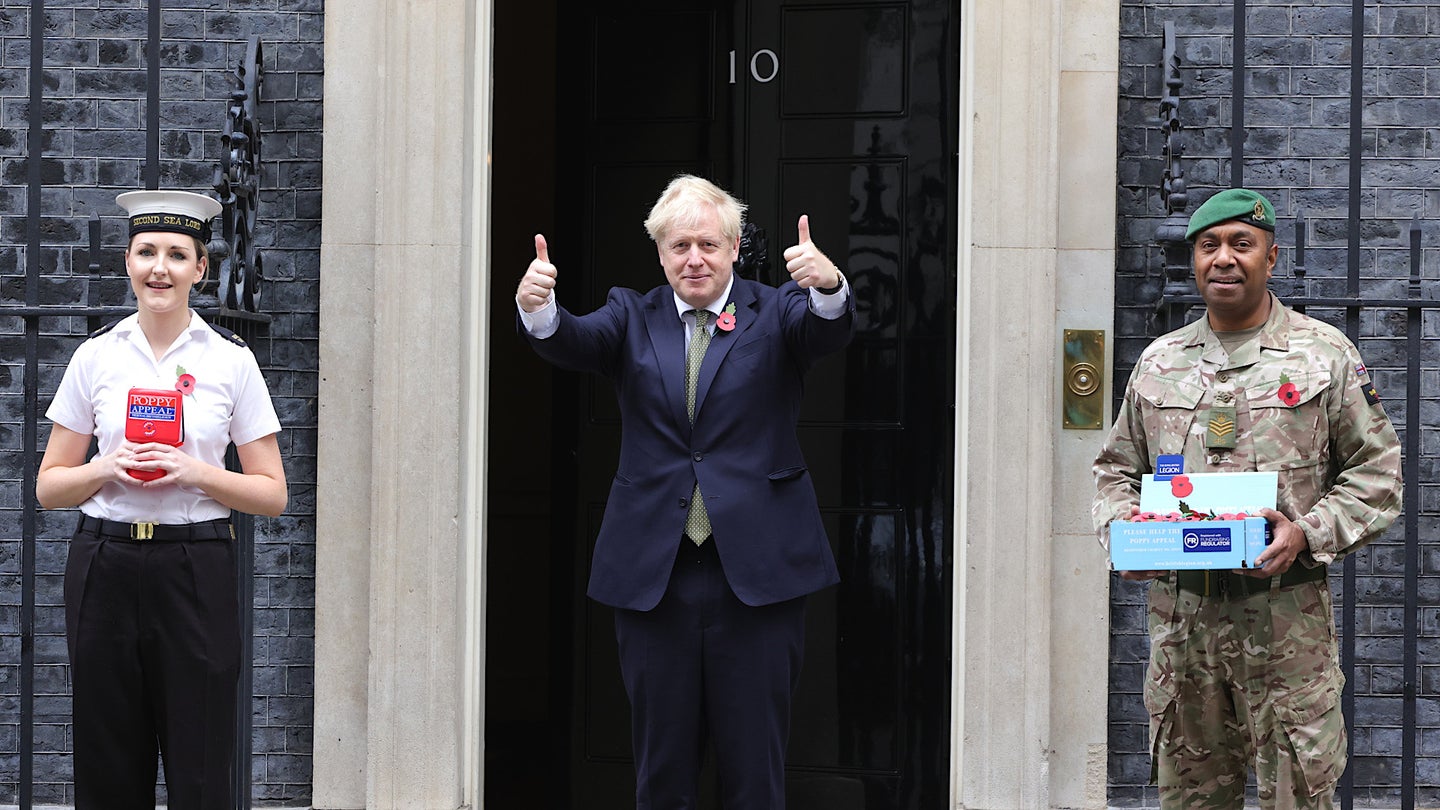BYJOSEPH TREVITHICK

The U.K. government has announced plans for a major increase in defense spending, adding a projected total of nearly $22 billion to the budget over the next four years. Details about the complete plan are still emerging, but Prime Minister Boris Johnson and the U.K. Ministry of Defense have said that the additional funding will help support the acquisition of a new class of warships, known as the Type 32, and the development of the Tempest stealth fighter, as well as the creation of a new dedicated Space Command and National Cyber Force, among other lines of effort.
Prime Minister Johnson made an initial statement to the U.K. Parliament's House of Commons regarding the defense spending plan on Nov. 19, 2020, and the U.K. Ministry of Defense issued its own statement on the same day. It's worth noting that this additional funding is on top of a previous commitment to add $2 billion more to the country's defense budget, with the combined planned increase being approximately $24.1 billion through 2024. The United Kingdom's total defense spending across this period is expected to be just under $253.3 billion. This will also keep the United Kingdom well above the defense spending target set out for members of the NATO alliance, which is two percent of a country's gross domestic product.
"For decades, British governments have trimmed and cheese-pared our defense budget and if we go on like this, we risk waking up to discover that our armed forces – the pride of Britain – have fallen below the minimum threshold of viability, and once lost, they could never be regained," Johnson told Members of Parliament in the House of Commons. "That outcome would not only be craven, it would jeopardize the security of the British people, amounting to a dereliction of duty for any Prime Minister. So I refused to vindicate any pessimistic forecasters there have been by taking up the scalpel yet again."
So far, details about exactly how the extra defense funds will get used are limited, but here is a basic breakdown of what we know so far:
Commits the United Kingdom to buy an unspecified number of Type 32 warships, the exact design and capabilities of which are presently unknown.
Will help fund the continued construction of the planned eight Type 26 and five Type 31 frigates for the Royal Navy.
Will help pay for the "future solid support ships that will supply our Carrier Strike Group" and new multi-role research vessels.
Adds approximately $1.98 billion for research and development efforts across the U.K. military.
This includes additional funds for the United Kingdom's Future Air Combat System (FCAS) effort, which includes the Tempest stealth fighter, and should not be confused with the Franco-German effort of the same name.
Prime Minister Johnson specifically highlighted drone swarm technology, directed energy weapons, developments in artificial intelligence, and improved networking for U.K. armed forces as other areas of focus that could receive additional funding.
Pays for the creation of a new U.K. Space Command.
This Space Command will oversee the first launch of a U.K. satellite onboard a U.K. rocket from a site in Scotland, which is scheduled to take occur in 2022.
Includes funding for a dedicated National Cyber Force to be operated in cooperation between the Ministry of Defense and the country's General Communications Headquarters (GCHQ), which is analogous to the U.S. National Security Agency (NSA).
Funds the establishment of a new Artificial Intelligence Center for the U.K. armed forces.
Help create up to 10,000 jobs in the U.K. defense sector each year over the next four years.
While there is clearly still much to learn about the U.K. government's plans for this defense spending plus-up, this list is already notable in a number of ways.
The announcement of plans to buy new Type 32 warships are particularly interesting. It's unclear if this nomenclature reflects some kind of relationship to the Type 31 class, which will be variants of the Babcock Group's Arrowhead 140 frigate design, itself derived from the Danish Iver Huitfeldt class. It is possible that these ships may be an improved, more capable subvariant of the Type 31.
Regardless, there have long been questions about whether the Royal Navy will have sufficient escorts for its Queen Elizabeth class aircraft carriers in the coming years based on the total number of Type 26s and Type 31s it presently plans to acquire and with the expected steady retirements of its exiting Type 23 frigates. This is an issue that The War Zone has highlighted on numerous occasions. These additional ships could potentially help address this potential shortfall in the country's surface fleets. It's also worth noting that the U.K. parliament released a report just last week raising concerns about how a lack of funding could hobble the Royal Navy's new carrier strike capabilities.
It's perhaps less surprising that there is a desire to provide additional money for FCAS and drone swarm developments. The U.K. government has laid out an ambitious plan for the Tempest stealth fighter, in particular, which you can read about in this previous War Zone feature, but questions have remained about where the necessary funding for that project might come from. It's also not clear yet how this defense spending increase may impact how many F-35 Joint Strike Fighters the U.K. Royal Air Force ultimately receives.

LEONARDO
The creation of a U.K. Space Command is also well in line with what the country's allies, especially the United States, which has created an entirely new branch to oversee space operations, are doing in this regard. Still, it does underscore how vital, and contested, space is for military operations already for the United Kingdom and its allies and partners. This domain is only set to become more important as time goes on.
The same goes for the announcements relating to cyber warfare and artificial intelligence. The U.S. military first established its Cyber Command in 2010, which is commanded by the same individual who serves as the director of the NSA, the exact same kind of structure the United Kingdom now says it is looking to adopt with regards to operations in cyberspace. The Pentagon also established a Joint Artificial Intelligence Center (JAIC) in 2018 to serve as a focal point for work in this increasingly critical arena across the U.S. military.
It's also worth pointing out that there is virtually no mention of funding for capabilities focused primarily on the British Army. Experts have already raised concerns about whether this might, despite Prime Minister Johnson's pronouncements, point to cuts in planned modernization efforts for the country's land forces, including new tanks or other armored vehicles. It's worth noting that the British Army, as well as the the Royal Marines, have been steadily shrinking in size for years now.
"We shall reshape our army for the age of networked warfare, allowing better equipped soldiers to deploy more quickly, and strengthening the ability of our Special Forces to operate covertly against our most sophisticated adversaries," Prime Minister Johnson told Members of Parliament.
Of course, no matter what the U.K. government's current defense spending plans are, it remains very much to be seen whether they will be able to implement them in full, or even in part, over the next four years. The ongoing COVID-19 pandemic continues to impact the United Kingdom and has already had a highly negative impact on its economy, amid a global economic downturn. At the same time, the U.K. government is still pursuing its departure from the European Union, possibly without formal agreements on trade and other issues with that bloc in place, which threatens to cause further economic uncertainty, at least in the near term.
There is political uncertainty, too. Johnson is the third U.K. Prime Minister to take office since the country's 2015 general election and assumed the role after his predecessor, Theresa May, stepped down in 2019 after Parliament rejected her proposed withdrawal agreement with the European Union three times. May had been leading a minority government since 2017, but had managed to survive two votes of no confidence.
"Next year represents a huge opportunity for this country, and Defense will be at the forefront of creating the jobs and business opportunities that will help us build back from the pandemic," U.K. Defense Secretary Ben Wallace said of the increased defense spending plan. "Over the next few months, I will set out in more detail our ambitious agenda for Defense."
It will be very interesting to learn more about what the United Kingdom expects to do with this defense spending increase and how the country plans to implement those initiatives. Though definitely ambitious, the plan, as we understand it now, certainly focuses on a number of key areas that reflect broader military trends around the world.
No comments:
Post a Comment